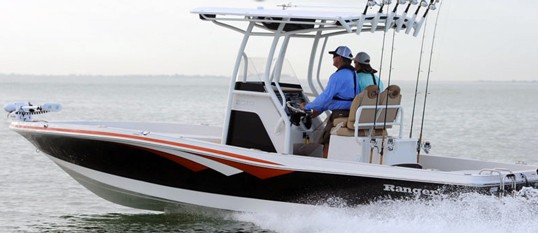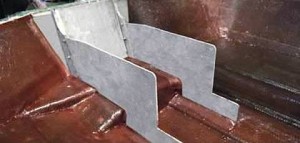Ranger 2510 Bay Ranger: Cut to the Chase
The new 2510 Bay Ranger from Ranger Boats is a predator with teeth. Sharp teeth.
Yo, fish: give me a hot summer afternoon on the Ranger 2510 Bay Ranger, and I’ll find a nice cool place for you to spend the rest of the day. A very, very cool place. Don’t worry about finding enough room, because the overboard-draining integrated fishbox on this boat houses a whopping 320 quarts. If you and your buddies just can’t stop snapping at my baits and that fishbox does fill up, I’ll simply spill my drinks and food out onto the deck and make a nice comfy spot for you in the 120 quart cooler. And if your little brothers and sisters wants to come along for the ride, that’s no problem either. They can enjoy the 40-gallon re-circulating aerated livewell built into the leaning post.
Crush and Run
Yes, fishing is the main mission—the only mission—of this boat, but we’re going to depart that topic for just a moment. Because before you ever cast a line, you’ve got to run to the hotspot. And even though we didn’t have rods onboard when I tested the 2510 Bay Ranger (tragic!), I still had a heck of a lot of fun. I can give you 300 reasons why. Three hundred four-stroke reasons, that is, because with the Yamaha F300 bolted to the back of this boat performance is ballistic.
Once we got beyond the speed-zone I put the pedal to the metal and in five seconds we were on plane. In less than 30 seconds we were ripping across Biscayne Bay at 50 MPH. And then the real fun began, when I started spinning the wheel. This is a hull you can get thoroughly aggressive with, and it keeps a solid grip through hair-pin turns at high speed. As long as you don’t goose the standard 12” hydraulic jack plate too much the prop doesn’t gulp air, and the suicide-knob on the standard hydraulic-tilt steering wheel lets you go lock-to-lock in the blink of an eye.
Fuel economy is respectable, too, peaking out at 3.5 MPG while cruising at about 30 MPH. Most anglers should plan on getting more like 2.6 MPG, though, because that’s the economy you’ll see at around 40 MPH and 4500 RPM. Assuming conditions allow, can you stand to back off on the throttle and do 25-percent less speed to save on fuel? Me neither.
Sea conditions do, of course, force a slow-down from time to time. But on the 2510 Bay Ranger you’ll be among the last in the fleet to find it necessary. Though it was calm when I ran this boat, there were dozens of other boats running up and down the channel, and plenty of wakes large enough to send us airborne. Sure, we did thud from time to time on some re-entries—remember, this is a 25’ boat, not a 50’ convertible—but the complete absence of vibrations, rattles, and hollow-sounding impacts gave me a lot of confidence in both seakeeping abilities and ruggedness.
Nuts and Bolts
A big part of the credit for that solid feel goes to Ranger’s construction techniques. High-density urethane core sandwiches, a foam-cored stringer grid, and vacuum molding are all in the mix, though perhaps the most impressive construction technique Ranger uses is pultrusion. High-stress parts of the boat, like the transom and backing plates, are extruded, saturated with resin, and tensioned through a heated die. The resulting fiberglass part is denser, stiffer, and stronger than traditionally-molded fiberglass, it has better screw retention, and the parts are more consistent.
Net result? When the 2510 smashes into a wall of water at 50 MPH you get a muted thud, not a hollow drumming that reverberates through your spine. That—and the hefty 97 gallon fuel capacity—means longer runs through open waters, which opens up more fishing opportunities.
And once you get there, there should be no shortage of rods onboard. A pair of locking rodboxes under the foredeck will hold rigs up to 9’6” long, and Ranger’s power-vented system makes sure they dry out quickly in there. Rod boxes like this, taken out of Ranger’s bass boat playbook, are an oddity on bay boats. On the downside, if you use them as intended you’ll also lose compartment space traditionally used for bulk stowage on this type of boat. But if you care about keeping your rods and reels in top condition, these boxes are sure to help.
Another bass-boatish trick Ranger imports into this mix is packaging the boat with a RangerTrail aluminum trailer package. It’s a tandem-axle rig with torsion-axle suspension, a swing-away tongue, LED lights, aluminum wheels, retractable integrated tie-downs, a center-swing jack stand, and oil-bathed bearings. I’m not sure I’m sold on the idea of oil-bath bearings for saltwater boats that are likely to sit for a while between uses (they don’t fail often but when they do it’s usually sudden and catastrophic, as opposed to the slow and noticeably loud death of greased bearings), but since Ranger gives you a three year stem-to-stern warranty that includes the trailer, it’s tough to complain. The boat, meanwhile, gets a lifetime structural warranty for the first owner, and a 10 year transferrable warranty carries over to a second owner.
Sitting Pretty
Another area in which this boat excels is seating. The helm seats mounted on the leaning post are comfy, as you'd expect. They are on most high-end bay boats. It's sitting on the flip-up bench seats that swing up from the aft casting deck that usually feels like, well, sitting on a bench. Ranger gives the spot a comfort-boost with a pair of slick hinged swing-up arm rests that self-deploy when you flip the seat open.
When nature calls, the console can also provide a comfort boost since it’s large enough to house a head. Note, however, that if you use the rodboxes for stowing rods and the console compartment for a head, you will be a bit short on bulk stowage. For most anglers, I’m guessing the console will be stuffed with gear bags and life jackets and will function as a head only when there’s a real “emergency.”
| Performance Data | |||
|---|---|---|---|
| Test conditions: Slight chop and numerous boat wakes, winds 5-10 knots, 3 POB | |||
| RPM | MPH | GPH | MPG |
| 1000 | 5.1 | 1.3 | 3.9 |
| 2000 | 8.4 | 3.7 | 2.3 |
| 3000 | 14.5 | 7.5 | 1.9 |
| 4000 | 33.7 | 11.2 | 3.0 |
| 5000 | 42.4 | 18.5 | 2.3 |
| 5850 | 50.0 | 26.4 | 1.9 |
| Power | Single 300 HP Yamaha F300 outboard, swinging a 15.25" x 18" three-bladed stainless-steel prop. Performance figures courtesy of Yamaha. | ||
That said, Ranger did do a good job of creating dedicated stowage for some of the items that fishermen consider must-haves. Three tackle boxes are built into the aft casting deck on one side of the bench seat, and a washdown with a self-coiling hose compartment is built in on the other side. There’s a dedicated five-gallon bucket stowage compartment in the foredeck. You'll find an anchor locker with a rack for a Danforth in the bow. And the hatches for most of these compartments are gasketed, guttered, and swing open on stainless-steel gas-assist struts.
How much?
Uh-oh. If you’re really interested in the 2510 Bay Ranger, this is that part of the review where your heart skips a beat and you might even break out in a sweat, as your eyes skip forward from word to word looking for that dreaded dollar sign... followed by a string of numbers. Can you afford this fishing machine?
Here's your answer: it MSRP’s at a little over $70,000. Rig it with max power, load it with big-ticket options like Power Poles, a trolling motor with multiple batteries and an onboard charger, then toss in oodles of electronics, and you could push that number up by another $10,000 to $20,000. But remember, the trailer is included in the price tag, as are a slew of standard features that many builders would consider options: the hydraulic jack plate, underwater LED lighting, trim tabs, eight gunwale and transom rodholders, fresh and raw water washdowns... the list goes on.
Whew—excuse me for a moment, I need to wipe the sweat from my own brow. I can’t say if there will ever be a 2510 Bay Ranger in my driveway, or for that matter, if I’ll ever get to step aboard one again. But one thing’s for sure: if I do, there will be rods onboard. Yo, fish: are you listening? It’s awful hot out there…
| Specifications | |
|---|---|
| Length | 24'7" |
| Beam | 8'6" |
| Draft (min.) | 1'1" |
| Deadrise | 14 degrees |
| Displacement | 3,050 lbs. |
| Fuel capacity | 97 gal. |
Other Choices: Another bodacious bay boat, the Grady-White 251 Coastal Explorer, leans a bit less towards pure fishability and a bit more towards family use. It posts similar performance, has more seating, slightly higher gunwales, and a higher price tag. One bay boat that’s priced close to the Ranger but tilts towards no-holds-barred fishability is the Pathfinder 2600 HPS Bay Crusher, which omits the aft seating and console head compartment in favor of allowing more fishing and stowage space.
See 2510 Bay Ranger listings.
Visit Ranger Boats for more info, and read Bay Boat Battles: What Makes One Better Than Another to gain more insight into bay boat design and construction.





















